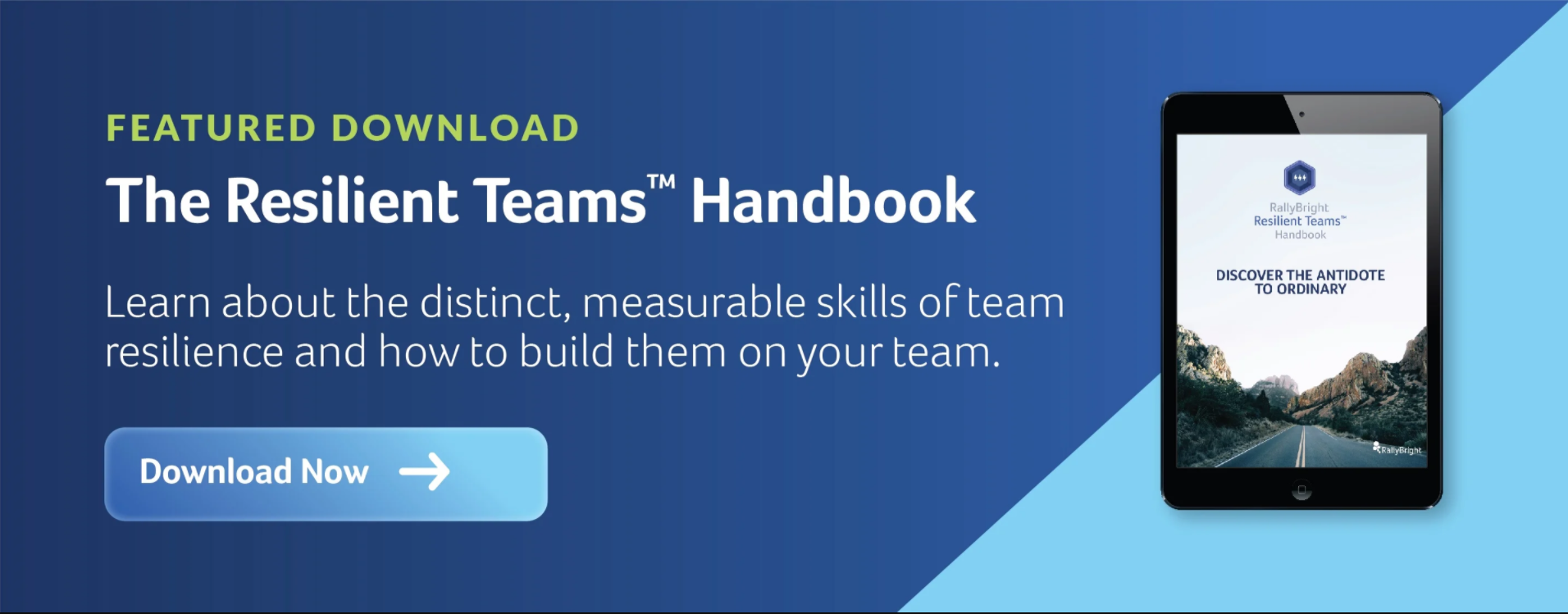When members of a workplace team are all on the same page, the synergy and output can be incredible. But common team problems, such as unclear priorities, lack of a common purpose, or avoiding productive conflict, can hinder performance and diminish results.
Working with corporate teams using the RallyBright platform, we see four familiar team problem teams and how those challenges negatively impact business. If any of these resonate with you, don’t worry. You can take concrete actions to help resolve them and get your team back on track.
1. Lack of a Shared, Agreed-Upon Purpose
Having a shared team purpose allows your team to accomplish things its members couldn’t do on their own. When everyone has a clear sense of direction and understands expected core behaviors, it’s much easier for a team to be collaborative, purposeful, and focused on priorities.
If your team hasn’t discussed its core purpose, each individual could work with different assumptions. This means they could work toward different goals, resulting in inefficiency and low resilience.
How to Prevent It
Take the time to discuss your overarching purpose as a team. Ask how you’d want stakeholders and partners to think, talk, and feel about the team and what key behaviors your team members should exhibit to achieve that purpose and live that brand.
2. Misalignment
If your team lacks alignment, whether it’s with customers, industries, or other internal units, it can create numerous challenges, including more silos and/or misunderstandings between teams. Being out of alignment with your internal stakeholders creates challenges and can damage your team’s reputation. It’s also hard to achieve peak performance if you aren’t in agreement on your business strategy.
Misalignment is also problematic for your customers.
Staying focused on your customers’ needs, wants, and pain points are difficult without a customer-first mindset. And it’s tough to retain business and achieve a true product/market fit. When a team is well-aligned, it’s easier to discover and take action on insights needed to be successful with your internal and external colleagues and customers.
How to Prevent It
Make your customers the focus. Develop customer personas to help you get inside the customer mindset and better understand their goals and worries.
It’s also helpful to review customer support requests and analyze customer feedback to look at their points of view firsthand. You can also meet with customers face-to-face, send surveys, or hold focus groups or interviews to gain deeper insights.
3. Not Ruthlessly Prioritizing Goals
This is the most common team problem we see. Similar to issues teams face when they lack clear purpose and goals, it’s also problematic when a team doesn’t prioritize its goals effectively. When goals are prioritized, performance improves, delivery is more consistent, and the team shows significant bias for action.
If you’re not clear on priorities, your team definitely isn’t. Everything becomes important, and people focus on different strategies. This can result in missed deadlines, upset customers, and loss of revenue.
You’ll have a high-performing, resilient team when everyone is on the same page about goals and objectives.
How to Prevent It
If you’re a manager, it’s a good idea to proactively identify your team’s top three to five business priorities and ensure every team member is in the loop. Knowing and sharing the metrics used to measure success is also essential. Track these metrics in a way the team can see them, such as a team performance dashboard where goals are transparent.
By reviewing the dashboard often as a team, you can enhance your team’s accountability. (A shared spreadsheet could also work.) Discuss progress with your group at least quarterly.
4. High Discomfort With Conflict
Conflict is an inevitable part of life, especially in the workplace. And some personality types are highly avoidant of conflict and disagreements.
But when well-handled, conflict is both productive and healthy. When work teams are highly uncomfortable with conflict, it can reveal a lack of strong connection between team members.
Healthy, high-performing teams share optimism and a growth mindset. They also have a sense of trust and safety, which allows open communication and fosters a willingness to make individual sacrifices for the team.
However, team dynamics will weaken if communication is suffering and team members are uncomfortable dealing with issues. Employees will eventually become less engaged. This often eventually leads to poor business results.
How to Prevent It
Boosting engagement and connection on your team will make it easier for the group to build trust and handle conflict when it arises. It’s also important that team members feel safe sharing their opinions and perspectives. Teams, like people, have distinct conflict styles, so it’s important to help your team understand theirs.
Reinforce the message that productive conflict is normal and healthy, but passive-aggressive or domineering behavior won’t fly. Keep in mind that varying personality types have different conflict styles and prefer to resolve disagreements differently. Work to nurture team relationships and recognize team members regularly so that when conflict pops up, it doesn’t create an irreparable rift.
None of us humans are perfect. We’ll inevitably face at least one of these problems on a team we’re part of.
This is especially true for teams that are large or contain vastly different personality types. But if you proactively work to prevent team problems and tackle them quickly when they arise, you’ll build a stronger, more resilient, and higher-performing team.

7 Additional Ways to Avoid Team Challenges
When diverse groups gather together, you can expect disagreements and conflicts to arise. However, when teams can work together effectively, these issues can quickly be overcome, and disruptive challenges can be avoided.
Effective teams prioritize communication and use setbacks as stepping stones for innovation. To reach such a high level of synergy, consider how these tips can help you improve your team dynamics and avoid ongoing conflicts.
1. Foster Strong Team Relationships
Humans are naturally social creatures. Full-time employees spend a third of their lives at work, and this time shouldn’t be spent in isolation.
According to a new study, people want more friends at work. In fact, 53% would even trade some compensation for more meaningful relationships with colleagues, and 43% believe their company should be doing more to promote workplace connections.
Forging strong relationships at work is challenging, yet teams need them to collaborate successfully and build a stronger team. By developing strong communication channels and empathetic teams, you can create an environment that naturally fosters relationships in the workplace.
Team leaders can set the tone by practicing active listening and encouraging all team members to have a voice. Encouraging collaboration among team members can help them improve their communication skills and get to know each other better.
2. Define Clear Job Roles
Without clear roles, teamwork can dissolve into uneven performance levels and a lack of accountability. When you work to develop specific roles in a way that clarifies the responsibilities of the position as well as how they contribute to organizational goals, employees have a clear definition of the why behind the work.
Arranging these roles to ensure that no employee is disproportionately saddled with redundant tasks can help improve engagement and overall team satisfaction. When every member is aware of their specific responsibilities, you can develop a culture of accountability.
3. Look Beyond the Hierarchy
Team leaders are most effective when they inspire enhanced performance instead of demanding it. An authoritative hierarchy develops anxiety and stress, limiting collaboration and innovative thinking.
Develop a workflow that presents you as an empathetic individual and a genuine authority through your actions as a team leader. Seek ways to drop the formality of leadership and foster collaboration for a truly nurturing team dynamic that helps build a sense of belonging.
4. Hold Department Events During Office Hours
Close-knit teams communicate well during various settings and situations to effectively overcome challenges and produce great results. Yet, fostering such unfettered connections in a typical work environment can be difficult.
Team building activities unrelated to work can help employees see each other in a different light and help build connections. However, requiring employees to come to work events during their free time can ruin the effect.
You can create a fun interruption that fosters teamwork and brings colleagues closer together by holding team-building events during office hours. When teams collaborate to compete against other departments in a fun environment, they can transfer the same energetic communications to the office to complete projects with ease. Occasionally joining teams across departments can build a culture of collaboration and belonging across the entire organization.
5. Develop a Mentorship Program
Mentorship programs allow employees to see each other in a different light. They also help organizations spread vital company knowledge across the workforce. Mentorship programs are a great way to help develop employees for future leadership roles.
However, they can also teach employees about new technology and increase cross-training opportunities that allow them to work across departments. Mentorships within teams can help team members develop empathy and improve communication skills. They can also help employees build confidence by displaying their strengths.
6. Provide a Clear Understanding of Advancement Opportunities
Employees want to know they can advance within the organization they work for. Advancement opportunities increase employees’ confidence in their job security and the feeling that their efforts are an investment in their future.
Consequently, employers who provide advancement opportunities are more likely to reduce turnover. SHRM research reports that 68% of employees would stay with their employer throughout their career if their employer made an effort to upskill them, and 65% would stay if their employer made an effort to reskill them.
The fact is, most employers can see the value of internal hiring and advancement opportunities within the company. The disconnect occurs because they don’t provide a clear path for employees to recognize potential opportunities.
While over two-thirds of employees seek advancement opportunities, 40% don’t see a clear path to advance their careers. Employers can improve retention efforts and team morale by learning employees’ individual career goals and helping them define a clear path within the company.
Such efforts improve relationships between employees as well. Rapid organizational turnover causes decreased employee morale and limited connectivity between coworkers. When employers define paths for advancement, team members can confidently forge long-lasting relationships.
7. Encourage Peer Recognition
Remember when we mentioned employees seek meaningful relationships in the workplace? Peer recognition goes hand-in-hand with this need. Employees usually expect recognition from company leaders for their efforts or achievements.
However, recognition from peers within a team can be a powerful motivator. As a leader, make an effort to show gratitude for the work put forth by employees. Encourage team members to extend the same gratitude toward each other to see improved communication and collaboration.
The Importance of Solving Team Problems
Regardless of company efforts, disagreements and conflicts will arise between team members. Team conflicts alone aren’t necessarily a bad thing.
After all, if employees never voice opposing opinions, teams are subject to groupthink and stalled innovation. Since conflict is unavoidable, the goal becomes productive conflict.
When teams don’t learn to develop healthy communication that encourages an open exchange of ideas, repetitive and frequent arguments are likely to occur. Failing to get to the root of team problems or leaving conflicts unresolved can negatively impact morale and productivity resulting in an uncomfortable work environment.
Such an environment can stifle employee involvement, dampen creativity, and limit team connectivity. As employee engagement declines, so does productivity and performance.
Overcoming Team Building Challenges Through Understanding
Innovative and successful teams are made when diverse people collaborate and share ideas. However, poor communication can lead to team breakdowns and lowered morale.
Like other relationships, those between team members are built through effective communication and empathetic listening. This can only occur when team members can recognize how their personalities are reflected in conflict styles and workplace behavior.
Want to know which team-building strategies to use with your team members? The key is to identify and understand employee personalities. Schedule a demo and learn how we can help.


